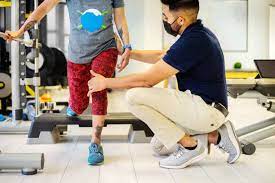Sports injuries are a common concern among athletes and coaches. They not only hinder immediate performance but can also have lasting effects on an athlete’s health and career. However, by implementing effective injury prevention strategies, athletes can significantly reduce the risk of getting injured and ensure they perform at their best. In this comprehensive guide, we will explore various techniques to prevent sports injuries, covering warm-up and cool-down routines, proper technique and form, conditioning and strength training, rest and recovery, sports gear and equipment, nutrition and hydration, early intervention, avoiding overtraining and burnout, sports-specific precautions, psychological readiness, and monitoring progress.
Understanding Common Sports Injuries
Before diving into prevention methods, let’s briefly discuss some of the most common sports injuries. These may include sprains (injuries to ligaments), strains (injuries to muscles or tendons), fractures (broken bones), and dislocations (joints moving out of position). Common sports-related injuries often result from overuse, sudden impact, or improper movement patterns.
Warm-up and Cool Down Techniques
Warming up before engaging in physical activity is crucial for injury prevention. A proper warm-up gradually increases blood flow to the muscles, elevates body temperature, and enhances flexibility. Dynamic stretching, where movements mimic those used in the sport, prepares the body for action. After the activity, a cool-down phase involving static stretching and relaxation techniques helps muscles recover and reduces soreness.
Proper Technique and Form
Using proper technique and form is essential for preventing sports injuries. Incorrect movements, such as improper running or landing mechanics, can strain muscles and joints, leading to injuries. Athletes must undergo regular skill and form training, and coaches can provide valuable feedback and guidance to help athletes maintain proper mechanics during sports activities.
Conditioning and Strength Training
Building overall fitness and strength is a vital aspect of injury prevention. Targeted exercises tailored to specific sports and muscle groups can improve performance and reduce the risk of injuries. Engaging in cross-training activities, such as swimming or cycling, can also help balance muscle development and reduce strain on particular areas.
Rest and Recovery
Rest and recovery are often underestimated in injury prevention. Giving the body sufficient time to recover allows muscles to repair and rebuild after strenuous workouts. Adequate sleep is particularly important, as it supports physical and mental well-being. Incorporating rest days into training schedules and engaging in active recovery practices, like gentle stretching or yoga, promote optimal athletic performance.
Proper Sports Gear and Equipment
Wearing appropriate sports gear and protective equipment is crucial for preventing injuries. Helmets, pads, braces, and other safety equipment are designed to absorb impact and reduce the risk of serious injuries during sports activities. It is essential to ensure that all gear fits properly and is well-maintained for optimal protection.
Nutrition and Hydration
Proper nutrition and hydration play a significant role in athletic performance and injury prevention. A well-balanced diet provides essential nutrients for muscle recovery, tissue repair, and overall health. Foods rich in proteins, antioxidants, and vitamins are particularly beneficial. Staying hydrated before, during, and after exercise helps maintain performance and prevents heat-related injuries.
Injury Recognition and Early Intervention
Recognizing the signs of potential sports injuries and taking early action is vital in preventing minor issues from escalating. Athletes should be educated about common injury symptoms, such as pain, swelling, or limited mobility, and encouraged to report any discomfort. Seeking immediate medical attention when necessary can accelerate recovery and prevent further damage.
Avoiding Overtraining and Burnout
While dedication and hard work are commendable, overtraining can lead to burnout and increased injury risk. Athletes must strike a balance between training and rest to avoid physical and mental exhaustion. Recognizing the signs of burnout, such as persistent fatigue and reduced motivation, is crucial for injury prevention.
Sports-Specific Precautions
Different sports come with unique injury risks, and athletes should be aware of these risks to implement suitable prevention strategies. Contact sports like football or rugby may require additional emphasis on proper tackling techniques and protective gear. High-impact sports, such as gymnastics or basketball, may benefit from specific conditioning exercises to minimize injury risk.
Psychological Readiness
Mental preparedness is an essential component of injury prevention. Stress and anxiety can affect an athlete’s performance and increase the risk of injuries. Engaging in relaxation techniques, mindfulness practices, and visualization exercises can foster psychological readiness and resilience in the face of pressure and competition.
Monitoring and Tracking Progress
Keeping records of training, injuries, and recovery can offer valuable insights for athletes and coaches. Tracking progress helps identify patterns, such as recurring injuries or successful training methods. Utilizing technology, such as wearable devices, can provide additional data on an athlete’s performance and health, facilitating personalized injury prevention strategies.
Conclusion
Injury prevention should be a top priority for all athletes and sports enthusiasts. By understanding common sports injuries and implementing comprehensive strategies, such as warm-up and cool-down routines, proper technique and form, conditioning and strength training, rest and recovery, appropriate sports gear, nutrition and hydration, early intervention, avoiding overtraining, sports-specific precautions, psychological readiness, and progress monitoring, athletes can safeguard their performance and long-term well-being. Remember, preventing injuries not only improves athletic performance but also ensures a safe and enjoyable sports experience for all.
